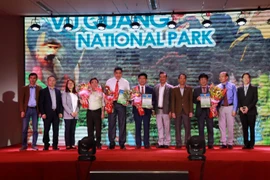Kien Giang (VNA) – U Minh Thuong National Park, one of the two most important peatland areas in Vietnam, boasts unique and rare features that are hard to be found anywhere else in the country and the world.
Located about 65km to the southwest of Rach Gia city, the southern province of Kien Giang, U Minh Thuong National Park forms part of the Kien Giang Biosphere Reserve.
Founded in 2002, the park is surrounded by a 60km-long embankment system and covers 21,122ha of land in U Minh Thuong district, including 8,053ha of the core zone and 13,069ha of the buffer zone.
At its 19th session in Paris on October 27, 2006, UNESCO designated the Kien Giang Biosphere Reserve, which includes marine and insular areas, as part of the World Network of Biosphere Reserves.
This reserve is not simply the fifth Vietnamese ones earning UNESCO’s recognition but also the second largest among the nine biospheres reserves in the country, following the area located in the west of the central province of Nghe An.
U Minh Thuong National Park is in the core are of the Kien Giang reserve. Among the forest ecosystems on acid sulfate soil in the Mekong Delta, only this park owns characteristics of a purely primeval forest.
A survey in 1995 showed that U Minh Thuong boasts 8,053ha of primeval forest, about 3,000ha of which dates back some 6,000 years ago.
Additionally, the park is also one of the two most important peatland areas in Vietnam, the other is U Minh Ha in the neighbouring province of Ca Mau.
The cajuput forest ecosystem on peatland here holds special importance as it nurtures hundreds of wild animals, including birds, mammals, reptiles, amphibians, fish, insects and many aquatic species.
Thirty-two mammal species have been found in this park, including 10 species listed in Vietnam’s Red Data Book and the International Union for Conservation of Nature (IUCN) Red List like hairy-nosed otter, fishing cat, Asian palm civet, Finlayson's squirrel and Sunda pangolin. It also provides habitat for 188 bird species, including eight threatened globally such as spot-billed pelican, greater adjutant, black-headed Ibis, sociable weaver, grey-headed fish eagle and black eagle; 54 reptile and amphibian species, including eight in Vietnam’s Red Data Book like reticulated python, banded krait and king cobra; along with 34 fish species.
Moreover, it owns the richest biodiversity in terms of plants in the Mekong Delta, habouring more than 254 plant species.
So far, 72 rare animal and plant species listed in Vietnam’s Red Data Book (2007) and the IUCN Red List (2012) have been spotted in U Minh Thuong National Park.
Over the past years, authorities of Kien Giang province has made strong efforts to conserve and recover natural resources on peatland so as to keep the wildness and intactness of the ecosystem and biodiversity in the National Park.
In 2012, the park was designated as the first ASEAN Heritage Park on peatland in Southeast Asia, becoming the fifth ASEAN Heritage Park in Vietnam. In 2015, it was recognised as a Ramsar site – a wetland of international importance, the 2,228th in the world and the eighth in Vietnam.
Given the park’s natural beauty and rich biodiversity, local authorities have been carrying out a project to develop eco-tourism in U Minh Thuong for 2019 – 2020 with a vision to 2030, with a total investment of over 150 billion VND (6.46 million USD).
Vice Chairman of the Kien Giang provincial People’s Committee Mai Anh Nhin said that the project aims to preserve natural resources and biodiversity, while making the most appropriate use of the forest’s potential so as to develop eco-tourism and environmental education in U Minh Thuong National Park.
Through the project, the province will gradually complete the infrastructure system in the park and create attractive tours so as to make U Minh Thuong one of the outstanding national parks in the Mekong Delta region and the world, he added./.






























